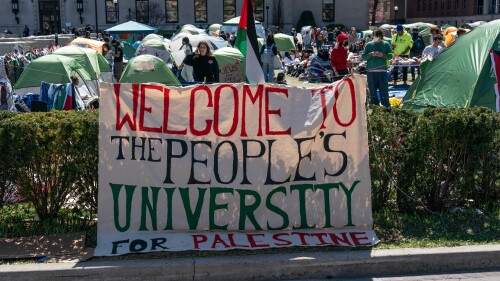Having closely watched the Arab uprisings that began just over a year ago, UCLA historian James Gelvin shudders whenever he hears the term “Arab Spring.”
“‘Spring’ implies renewal and joy, and we’re still a long way from that occurring as a result of any of the uprisings,” said Gelvin, a professor who specializes in the social and cultural history of the modern Middle East and is a faculty adviser at the UCLA International Institute’s Center for Near Eastern Studies. “Besides, since not one of the uprisings actually broke out in the spring, it really makes no sense.”
In a new book, Gelvin dispels this and other misconceptions surrounding the uprisings. “The Arab Uprisings: What Everyone Needs to Know,” which will be released Jan. 31 by Oxford University Press, also explores the causes, trajectories, significance and likely consequences of the events that began in December 2010, when rioting broke out in Tunisia after a street vendor set himself on fire to protest the police’s confiscation of the fruit and vegetables he was selling. The unrest ultimately led to the resignation of the country’s president on Jan. 16, 2011. Pro-democracy movements swept through the Middle East and North Africa, engulfing Egypt, then Bahrain, Morocco, Syria, Yemen, Libya and other states.
While Gelvin says “no one could have predicted the shape and depth of the uprisings,” he delineates in the book four distinct ways in which these rebellions unfolded, each rooted in the particular histories and structures of the nations involved.
Gelvin contends that Tunisia’s and Egypt’s long histories of state-building — unique in the Arab world — made it possible in those countries for an autonomous military to move against long-ruling autocrats. Thus, the “street phase” of the uprisings was speedy and relatively peaceful. Conversely, in Yemen and Libya, with their short histories as unified states, feeble institutions and weak sense of national identity, the regimes fragmented, resulting in protracted and violent uprisings — and a greater potential for revolutionary change than in Tunisia and Egypt, he says.
In Algeria, Syria and Bahrain, the ruling elites are so strongly bonded that institutions cannot splinter, nor can one part of the regime turn against another, as the army did in Tunisia and Egypt, Gelvin argues. “Ruling elites in these states know they must all hang together or they will all hang separately,” he said. “So these regimes are going to either be completely replaced or remain intact.”
Finally, there are the seven monarchies in the region besides Bahrain, where so far, protests demanding the reform of the system, rather than its replacement, have not yet evolved into uprisings.
Gelvin, who has written extensively on the history of the modern Middle East, said writing a history of contemporary events in the region presents a unique set of challenges because the “story is still unfolding, and the true impact of this phenomenon won’t be known for years, if ever.”
Written with the eye toward the non-specialist, “The Arab Uprisings” features a quick-hit, question-and-answer format that, unlike many books by academics, is presented in a clear, easy-to-understand manner. And at less than 160 pages, it is a relatively quick read.
“There is no academic-speak in this book,” Gelvin said. “When I write for a general audience, I write as if I were holding a conversation. Part of the challenge is to glean the information carefully so that the reader is not overwhelmed, while at the same time ensuring the story gets told thoroughly — a story that is a moving target.”
When asked what he thought was the biggest misconception Americans have about the uprisings, Gelvin said it involved the broad mix of participants.
“For about three weeks, Americans saw social-networking young people on the streets of Cairo,” he said. “They then apply these images elsewhere. Most Americans do not know that labor, for example, played a key role in the Tunisian and Egyptian uprisings, or the social breadth of the uprisings in Libya, Syria and elsewhere. These are mass movements. There are, after all, a lot of people in the Arab world angry about the conditions they are forced to live in and willing to put their lives on the line to correct them.”
Gelvin joined UCLA’s history department in 1995. “The Arab Uprisings: What Everyone Needs to Know” is his fourth book.



